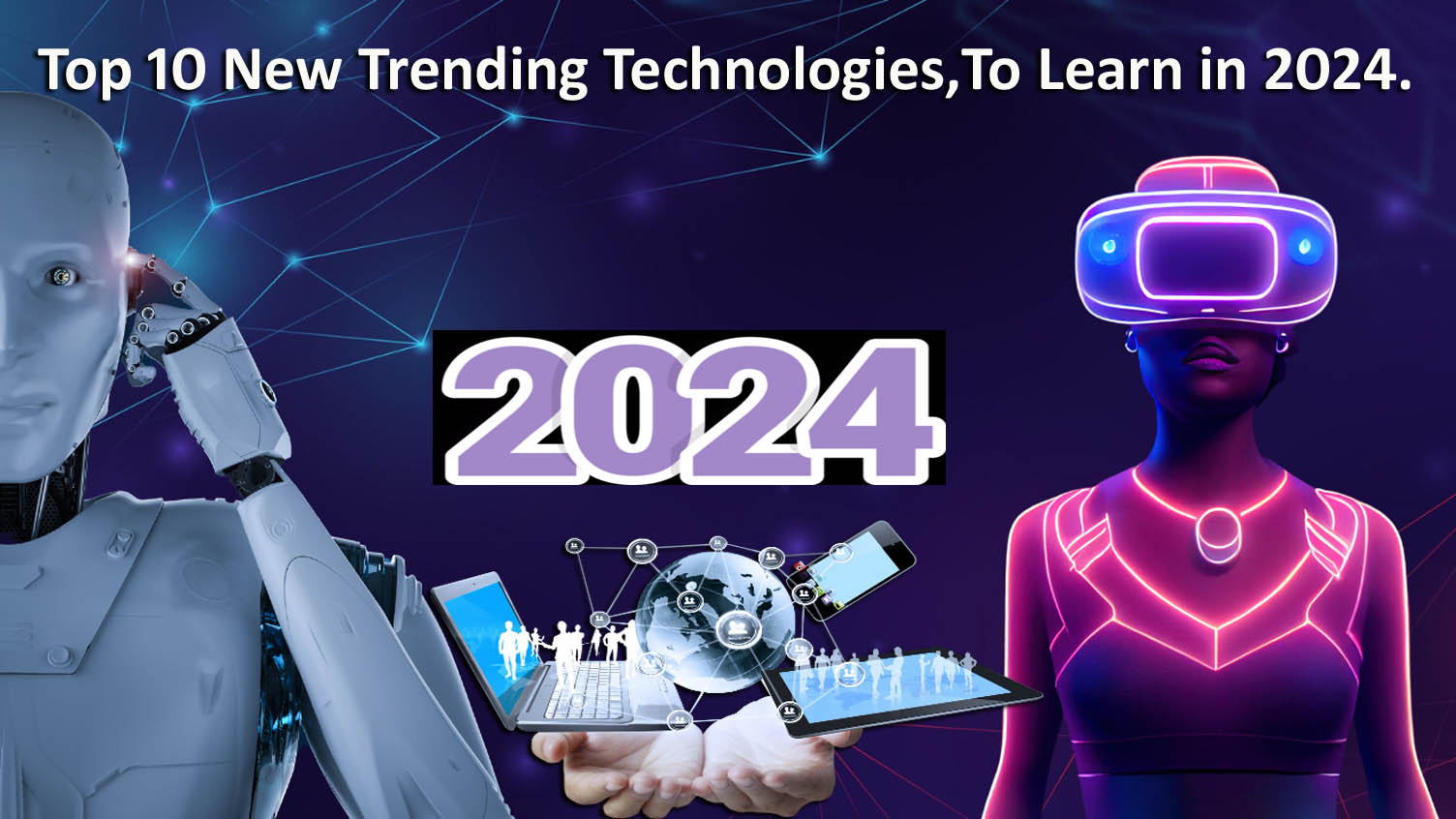Top 10 New Trending Technologies,To Learn in 2024.
In today’s dynamic technological landscape, staying at the forefront is imperative. Prepare to explore the most recent trends in technology that will undoubtedly shape the trajectory of your career!
Over the past six decades, technology has experienced remarkable progress. From the introduction of the IBM 350, a massive machine capable of storing a mere 3.5 MB of data, to the contemporary SD card, weighing only 2 grams yet boasting a storage capacity of 2 Terabytes, the journey has been extraordinary.
Amidst this remarkable evolution, one constant has prevailed: change. Technological advancements occur at a rapid pace, typically every 2-3 years. For professionals navigating the technology sector, staying abreast of these changes is not just beneficial; it’s essential for swift career advancement.
Whether you are an enthusiastic newcomer to the tech realm or a seasoned industry veteran, embracing the top 10 trending technologies poised to dominate in 2024 will unlock a realm of unprecedented opportunities. Top 10 New Trending Technologies
Top 10 New Trending Technologies.
-
Generative AI
-
Cybersecurity
-
Sustainable Tech Solutions
-
Cloud Computing & DevOps
-
Data Science & Analytics
-
Human-Computer Interaction
-
Blockchain
-
Full Stack Web Development
-
Virtual Reality/Augmented Reality
-
Robotic Process Automation
Adani Companies Unlisted
Top 20 Beautiful female singers in Bollywood 2023.
What is generative AI?
Generative AI, a form of artificial intelligence, is capable of producing diverse content, including text, images, audio, and synthetic data. The recent surge in interest surrounding generative AI is attributed to user-friendly interfaces that enable the rapid creation of high-quality text, graphics, and videos.
It’s essential to note that generative AI isn’t a recent innovation; it dates back to the 1960s with the introduction of chatbots. However, a significant breakthrough occurred in 2014 with the advent of generative adversarial networks (GANs), a type of machine learning algorithm. GANs allowed generative AI to produce convincingly authentic images, videos, and audio featuring real people.
This newfound capability has led to opportunities such as improved movie dubbing and enriched educational content. Simultaneously, concerns have arisen about deepfakes—digitally manipulated images or videos—and potential cybersecurity threats, including deceptive requests mimicking an employee’s superior.
Two recent critical advancements in generative AI’s mainstream adoption are transformers and the breakthrough language models they facilitated. Transformers, a type of machine learning, enabled the training of increasingly larger models without the need to pre-label all data. This allowed models to be trained on vast amounts of text, providing more in-depth answers. Transformers introduced the concept of attention, enabling models to track connections between words across entire documents, not just individual sentences. This capability extends beyond words to analyze code, proteins, chemicals, and DNA.
The rapid progress in large language models (LLMs), boasting billions or even trillions of parameters, marks a new era for generative AI. These models can generate engaging text, realistic images, and even produce entertaining sitcoms on the fly. Innovations in multimodal AI further empower teams to create content across various media types, including text, graphics, and video. Tools like Dall-E exemplify this capability by automatically generating images from textual descriptions or creating text captions from images.
Despite these breakthroughs, we remain in the early stages of utilizing generative AI for creating readable text and photorealistic graphics. Early implementations have faced challenges with accuracy, bias, hallucinations, and quirky responses. Nevertheless, the progress made suggests that generative AI’s inherent capabilities could significantly transform enterprise technology, influencing how businesses code, design drugs, develop products, reshape processes, and optimize supply chains in the future.
What is cybersecurity?
Cybersecurity is the practice of protecting computer systems, networks, and data from theft, damage, unauthorized access, or any form of unauthorized use. Its primary goal is to ensure the confidentiality, integrity, and availability of information and computing resources.
Key aspects of cybersecurity include:
Confidentiality: Ensuring that information is accessible only to those who are authorized to view it. This involves protecting data from unauthorized access or disclosure.
Integrity: Maintaining the accuracy and reliability of data and systems. This involves preventing unauthorized modification or tampering with data.
Availability: Ensuring that systems and data are available and accessible when needed. This involves preventing or minimizing disruptions due to cyberattacks or other incidents.
Authentication: Verifying the identity of users, systems, and devices to ensure that only authorized entities can access certain information or resources.
Authorization: Granting appropriate permissions and access levels to authenticated users, limiting access to only what is necessary for their roles or responsibilities.
Network Security: Protecting the security of networks and their components, including routers, switches, firewalls, and other devices, to prevent unauthorized access and data interception.
Endpoint Security: Securing individual devices such as computers, smartphones, and tablets to protect against malware, unauthorized access, and other threats.
Incident Response: Developing and implementing plans to respond to and mitigate the impact of cybersecurity incidents, such as data breaches or malware infections.
Security Awareness and Training: Educating users and employees about best practices for cybersecurity, including recognizing and avoiding potential threats like phishing attacks.
Encryption: Protecting data by converting it into a secure code to prevent unauthorized access or interception.
Vulnerability Management: Identifying and addressing weaknesses or vulnerabilities in systems and software to reduce the risk of exploitation by attackers.
Security Auditing and Monitoring: Regularly monitoring systems and networks for unusual or suspicious activity, and conducting security audits to identify and address potential issues.
Cybersecurity is crucial in today’s digital age, where businesses, governments, and individuals rely heavily on interconnected systems and digital communication. The ever-evolving nature of cyber threats requires continuous efforts to adapt and improve security measures to safeguard against new and emerging risks.
